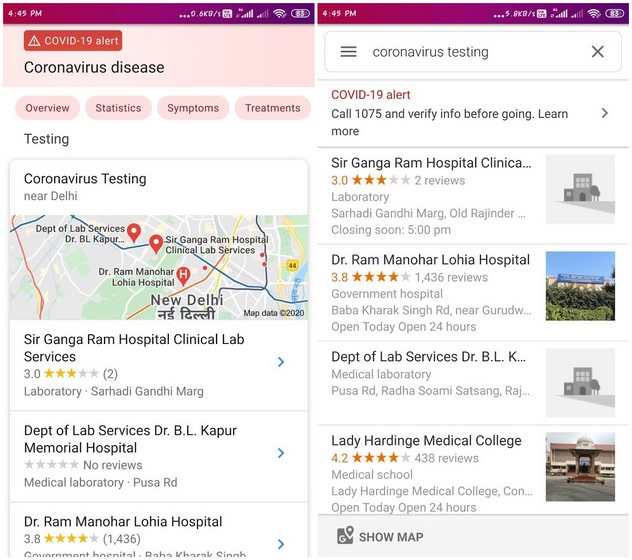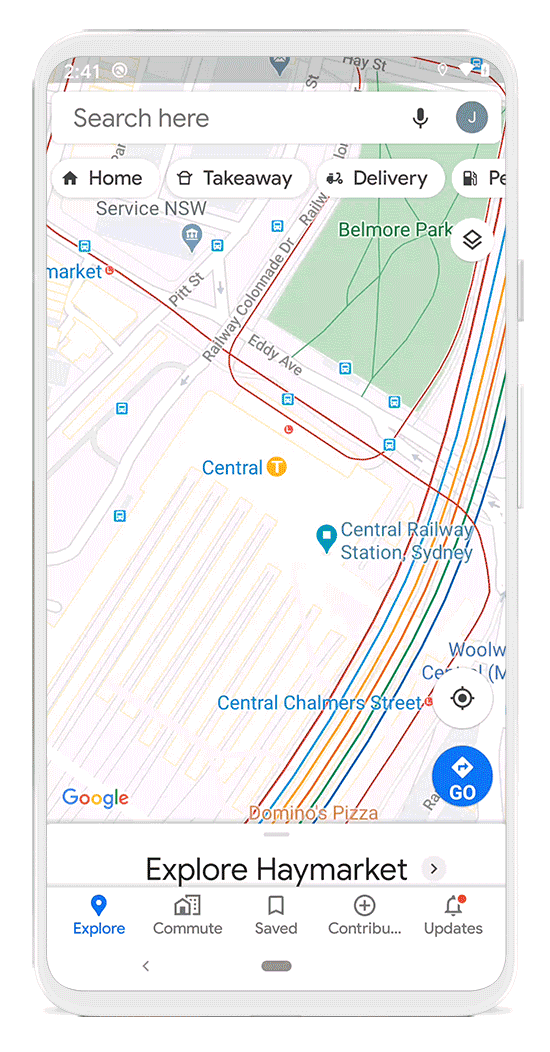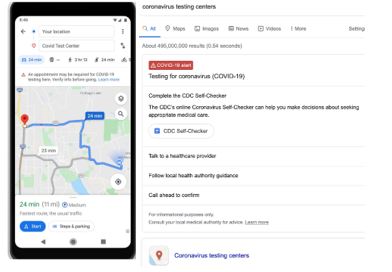Google Maps becomes game-changer in locating nearest COVID-19 Testing labs
In a press release on Friday, the company said that it has tied up with the Indian Council of Medical Research (ICMR) and MyGov to provide this info. The feature is available in English, as well as local languages, including Hindi, Bengali, Telugu, Tamil, Malayalam, Kannada, Marathi, and Gujarati. Announcing the feature, the official Twitter account of Google India said:“Working closely with @ICMRDELHI & @mygovindia, Google Maps, Google Assistant and Search are now beginning to surface testing centers in Hindi, English & 7 regional languages. Before going to a testing center, call the Govt. of India helpline – 1075 & get a doctor’s prescription”. Google in a tweet also stated that the company is closely working with the Indian Council of Medical Research (ICMR) and MyGov to provide users with information on authorized testing labs. At present, Google has integrated over 700 testing labs on Search, Assistant, and Maps spread across 300 cities. Google is working with authorities to identify and add more testing labs located across the country, it stated.
Google in April added the COVID-19 alert card on the Google Assistant snapshot that essentially provides information on the coronavirus outbreak. The central government and the state governments have also tried to ramp up efforts to find COVID-19-related information with apps such as Aarogya Setu. Google Maps will also now show if a trip’s navigation includes a COVID-19 checkpoint or restriction along your route, like when you’re crossing an international border. This is first launching with Canada, Mexico, and the U.S., and will display an alert on the directions screen if your route is impacted. Google didn’t indicate any plans to expand this to more countries.
Similarly, alerts will appear when you plan a trip to a medical facility or COVID-19 testing center. These alerts will be based on data Google receives from authoritative agencies, including local, state, and federal governments or from the center’s websites. Here, the idea is to make sure that people heading to a center are aware of the guidelines so they’re not turned away upon arrival. For instance, if the center won’t see you without an appointment, that would be noted.


How does the COVID-19 feature work on these Google Apps?
As per the statement issued by Google, the company has integrated 700 testing labs on Search, Assistant, and Maps across 300 cities. “Google is working with authorities to identify and add more testing labs located across the country and reiterates that it is important to follow the recommended guidelines that help determine testing eligibility before visiting,” the statement read.
There is also a Learn More tab next to search results to find authoritative information from the Ministry of Health and Family Welfare (MoHFW), Government of India. Earlier, Google Maps introduced a new feature that would let people know about crowded places and public transports. The feature will be made available to both Android and iOS users. It will be rolled out in countries including Argentina, Australia, Belgium, Brazil, Colombia, France, India, Mexico, Netherlands, Spain, Thailand, United Kingdom, and the US. While Google is making it easier to find a COVID-19 testing facility, some of these facilities are not offering tests to the general public. Some testing facilities are limited to certain groups. For example, Google’s map indexes some Veterans Health Clinics, where testing is limited to veterans and other selected groups. In other areas, Google does not list some public testing. For instance, in the San Antonio, Texas area, the company does not index three public, drive-thru testing facilities. But does index 11 locations of privately-owned Texas MedClinic urgent care clinics that are offering testing. The maps do index testing facilities of Project Baseline, which is powered by the Alphabet’s Verily unit.

Google Search
You can just search for ‘coronavirus testing’ or ‘COVID testing’ on the app or the website. That will get you the complete list of authorized COVID-19 testing centers around you.
Google Assistant
On Assistant, users will now see a ‘Testing’ tab on the search results page while using keywords like ‘coronavirus testing’.
Google Maps
Meanwhile, searching for the aforementioned keywords on Google Maps will yield a list of nearby testing labs. The service will also offer a link to Google Search for the government-mandated eligibility requirements.
TrackCorona
TrackCorona provides up-to-date, global information to help fight the pandemic. The website, which aggregates data from more than 17 authoritative sources, was created by undergraduates at Stanford, University of Virginia, and Virginia Tech. In addition to providing a detailed visualization of COVID-19’s global presence, the site provides information about the background of the virus, global travel restrictions, a historical timeline of how the virus has spread, and more. Since launch, the site has had over 9,300,000 page views.
Find the Masks
#findthemasks was built by volunteers to connect donors who have personal protective equipment (PPE) to the healthcare facilities, group homes, and shelters most in need of it. By mapping the PPE shortage and providing open data infrastructure, the site supports a wide range of grassroots efforts to move masks, gloves, thermometers, and even baby monitors out of basements to the frontlines where they can protect the workers who are taking care of us. Find a nearby donation site at findthemasks.com.
Iamsick.ca
Empower Health develops technology platforms that help patients find the care they need and help healthcare providers deliver the best quality of service to patients. To help people find locations to receive assessments for COVID-19, they’ve added information about COVID-19 assessment centers to the platform. Assessment centers are noted with a special marker on the map to help people quickly and easily identify the location closest to them.
Takeout Tracker
With many restaurants closing or switching to take out or delivery only, Takeout Tracker aims to give the people of Austin, Texas an up-to-date resource to find open restaurants, their current operating policies, hours and ordering information. Restaurants can submit their information for expedited listing, but the team also takes user reports and proactively updates as restaurant policies change. The site offers curated lists of recommendations from local industry veterans as well as controls to search, filter, and map their full list of 675+ restaurants.
Future enhancement
In several countries, Google says it will now display transit alerts from local agencies that will help users prepare for any government mandates that impact your ability to use public transit. For example, if services are closed or if you’re required to wear a mask, the alerts would include this information. These are launching now in Argentina, Australia, Belgium, Brazil, Colombia, France, India, Mexico, Netherlands, Spain, Thailand, United Kingdom, and the U.S., where Google has information from local transit agencies available, with more countries coming soon.
Scope for other companies & developers
Not-for-profit developers and organizations working on COVID-19-related websites or apps can apply for Google Maps Platform credits by filling out the application for credits. Our team has also compiled useful resources to help developers better understand the core features of Google Maps Platform that can be useful for building apps in our COVID-19 Developer Resource Hub. Next, we’ll highlight how a variety of our customers are helping local communities stay engaged even when they’re sheltering in place.
Conclusion
Google claims to have integrated over 700 testing labs on Search, Assistant, and Maps across 300 cities. The company also said it is “working with authorities to identify and add more testing labs located across the country and reiterates that it is important to follow the recommended guidelines that help determine testing eligibility before visiting.”
These additions were first announced in February, but are now globally available. They also include more granular accessibility information for wheelchair users, like where there are wheelchair accessible doors, seating, stop buttons, and more, Google says. The expanded set of features will be live on both iOS and Android, in the markets where they’re available.






